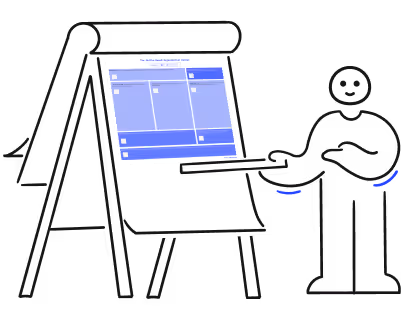Leveraging AI for DEI: the benefits of skill mapping for inclusive hiring

Empower your organization with the skills-based canvas.

Diversity, equity and inclusion (DEI) is at the forefront of discussions in the workplace. And it should be — a diverse and inclusive workplace can improve employee morale, increase productivity, and reduce employee turnover, which as we know have a positive impact on a company’s bottomline. Case in point: a report by McKinsey & Company found that companies with more diverse leadership teams are 25% more likely to see above average profitability within their industry.
However, biases and office politics continue to play a significant role in career advancement and compensation, leading to unequal opportunities for employees based on factors such as gender, race or even existing relationships that could lead to favoritism or nepotism (fans of HBO hit series Succession will know what we mean).
What if the key to making the workplace more human is by minimizing human biases? While this may sound counter-intuitive, emerging AI-powered technology can mitigate these issues by removing subconscious prejudices from decision making. By using a data-driven approach, skill mapping tools like Workleap Skills help managers and decision makers remove guesswork and subjectivity from the equation when it comes to assessing their teams. This, in turn, helps provide more equal opportunities for all employees to be recognized and valued based on their competencies and career development aspirations — not personal biases.
3 common areas where organizations fail to see their blind spots — and how to work around them to provide equal opportunities
The point of blindspots is that we are blind to them — and no organization, or individual part of an organization, is immune from having their own. In order to promote equal opportunities, and become an equal opportunity employer, these must be tackled. Recurrent blind spots employers experience are commonly be found within these contexts:
1. Distributed Workforce: As with the saying “you don’t know what you don’t know”, you also don’t know what you can’t see. With remote work and dispersed teams, it can be challenging to properly assess individual contributions and growth on the day-to-day. Skill mapping can help managers better evaluate team competencies and eliminate the risk of missing out on valuable contributions from more introverted or less vocal employees by giving equal weight to each member.
Skills are the great equalizer. They level the playing field on how we evaluate, develop and promote talent in a distributed workplace.
{emphasize}
Studies in 2022 show that remote work is exacerbating existing problems in the workplace:
95% experienced more race-related hostility in remote settings, and 23% of those aged 50 and above saw a surge in harassment and hostility.
36% of women and 42% of trans workers within tech industries reported an increase in gender-based harassment while working remotely during the pandemic
{emphasize}
2. Internal Talent Mobility: As organizations grow, visibility on new opportunities is crucial for employee development. Skill mapping helps level the playing field by organizing work around projects and outcomes, not roles and titles, providing greater visibility, opportunity and mobility for all employees. Adopting a skill-centric approach can help avoid creating asymmetrical systems that give unfair advantages to some.
{emphasize}
The importance of providing employees with opportunities for growth and development: According to a survey by LinkedIn, 94% of employees would stay at a company longer if it invested in their careers.
{emphasize}
3. Access to Mentorship and Learning: Mentorship and learning opportunities have traditionally been impacted by office politics and access to key decision-makers. Skill mapping can match employees seeking skill development with the right mentor, regardless of natural affinities, geographic proximity or professional degrees of separation.
{emphasize}
Investing in winning leadership teams helps employees grow… and stay
As we’ve already highlighted, companies who commit to diverse leadership are more financially successful. And strong leadership is worth the investment: 86% of professionals are more likely to stay in their jobs if they have access to mentorship.
{emphasize}
10 key biases skill mapping helps curb
Artifical Intelligence (AI) software doesn’t see people, it sees data points. Turns out this is the key to actually seeing people for who they really are – free of preconceptions and biases. Skill mapping can help curb biases by removing subjectivity from the decision-making processes around hiring, retention, and compensation, focusing on skills and competencies rather than factors that could cause discrimination such as gender, physical abilities or other personal traits.
What types of biases can impact hiring, employee promotion, pay and organizational culture? Here are the most common ones:
- Gender: Gender bias refers to prejudice and discrimination against individuals based on their gender, often leading to unequal opportunities and pay gaps between men and women.
{emphasize}
To this day, the Gender Pay Gap can still be observed. On average, women still earn only 83 cents to the dollar compared to men.
{emphasize}
- Race or Ethnicity: Race bias refers to prejudice and discrimination against individuals based on their race or ethnic background, leading to unequal opportunities and disparities in career progression and compensation.
{emphasize}
Black workers still earn less than their white counterparts: Black workers are earning nearly 24% less per hour on average than white workers, even after controlling for education, experience, and other individual characteristics.
{emphasize}
- Disability: Disability bias refers to prejudice and discrimination against individuals with disabilities, whether they are visible or not.
{emphasize}
People with disabilities form a pool of workers worth tapping into: Employees with disabilities often bring unique skills and perspectives to the workplace, leading to increased productivity and improved overall performance.
{emphasize}
- Personality: Personality bias refers to prejudice and discrimination based on an individual's personality, particularly the extrovert-introvert dichotomy.
{emphasize}
Types of personality bias phenomena include confirmation bias, stereotyping and the Halo Effect.
{emphasize}
- Age: In the workplace, there may be biases towards employees based on their age, whether they are perceived as too young or too old, which is also referred to as ageism.
{emphasize}
Age isn’t just a number, but it should be: 62% of workers aged 50 and over report to have personally seen or experienced age discrimination at work
{emphasize}
- Sexual Orientation: Bias towards employees based on their sexual orientation or gender identification can occur across all industries.
{emphasize}
LGBTQ workers face significant barriers to employment: 1/4 report being fired, denied a promotion, or experience some form of mistreatment in the workplace due to their sexual orientation or gender identity.
{emphasize}
- Religion: This refers to bias towards employees based on their religious beliefs, practices or affiliations.
{emphasize}
By law, employers must make reasonable accommodations for employees’ religious practices. However, unconscious bias throughout the hiring and interviewing process can still happen and are hard to discern.
{emphasize}
- Existing relationship: While building a valuable network can sometimes be merit-based (especially when relating to sales skills), bias towards employees who have relations with decision makers can take the form of favoritism, nepotism or cronyism.
{emphasize}
Favoritism happens no matter how experienced you are: In a survey of 303 US executives, 56% admitted to having favorite candidates and 96% of them would hire or promote their favorites rather than consider their professional abilities.
{emphasize}
By focusing on data rather than personal biases, AI technology can help eliminate discrimination and promote fairness in hiring, retention and compensation — making you an equal opportunity champion!
Making hiring, retention, and compensation more skill-centric and equal
Skills are often evaluated based on an employee’s years of experience or education. However, experience does not always equate to mastery. After all, some people will need five years to master a skill while some, who may be fast learners, may only need two. Applying a skill-centric approach ensures hiring managers focus on competency mapping rather than arbitrary data points like years occupying a particular job and title.
79% of HR professionals agree that unconscious bias exists in both recruitment and succession planning decisions. By embracing skill mapping and making it a core part of HR processes, organizations can thus create more equitable work environments and promote diversity, equity, and inclusion (DEI).
As an employer, the key is to work towards equality of opportunity rather than equality of outcome.
Compensation sees the most inequality between gender! 60% of women admit to having never negotiated their salary and rather change jobs for a better pay — while men are more likely to ask for a raise. Using skillstech can help achieve fairer outcomes based on true performance rather than a person’s abilities to negotiate a salary.
This shift towards a data-driven, skill-centric approach can help close the gender pay gap, provide better visibility and mobility opportunities for employees, and help connect employees with the right mentorship and learning opportunities to help them grow and develop.
Jumping into the future of hiring
Equity in the workplace is achievable. Workleap's skill mapping technology works by creating a clear and comprehensive picture of an employee's skills and competencies. By doing this, personal bias is removed from the equation and ensures that employee promotions and compensations are based on merit and skill, rather than favoritism or political alliances.
Workleap Skills also helps create an equitable work environment by providing a clear and transparent process for employee promotion, which helps to break down the barriers that often prevent underrepresented groups from advancing in their careers. By painting a comprehensive picture of their skill set, employees can see exactly what they need to work on to reach the next level in their careers. This not only empowers employees to take control of their own careers, but also helps create a more diverse and inclusive workplace.
In a climate where DEI in the workplace is non-negotiable, data-driven and biased-free tools are no longer unaffordable — and a must. By embracing tech solutions, companies are able to leap towards creating a more diverse, inclusive, equitable and successful future for their employees.
Ready to become an equal opportunity employer? Get in touch with our team to book a demo.
Monitor, support, and optimize your team's professional development.


%20(1).avif)


.avif)
.avif)




%202.avif)

